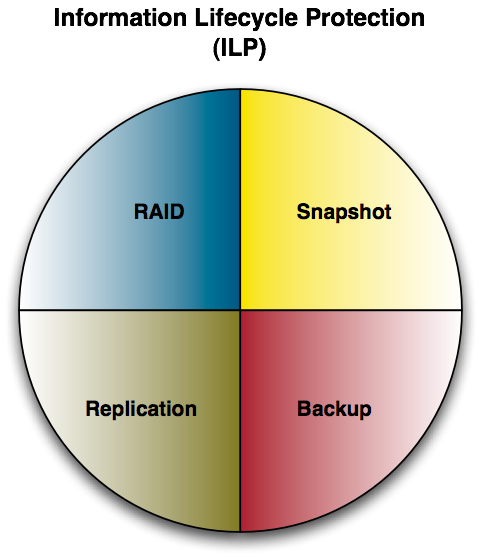In my opinion (and after all, this is my blog), there’s a fundamental misconception in the storage industry that backup is a part of Information Lifecycle Management (ILM).
My take is that backup has nothing to do with ILM. Backup instead belongs to a sister (or shadow) activity, Information Lifecycle Protection – ILP. The comparison between the two is somewhat analogous to the comparison I made in “Backup is a Production Activity” between operational production systems and infrastructure support production systems; that is, one is directly related to the operational aspects of the data, and the other exists to support the data.
Here’s an example of what Information Lifecycle Protection would look like:

Obviously there’s some simplification going on in the above diagram – for instance, I’ve encapsulated any online storage based fault-protection into “RAID”, but it does serve to get the basic message across.
If we look at say, Wikipedia’s entry on Information Lifecycle Management, backup is mentioned as being part of the operational aspects of ILM – this is actually a fairly standard definition of the perceived position of backup within ILM; however, standard definition or not, I have to disagree.
At its heart, ILM is about ensuring correct access and lifecycle retention policies for data: neither of these core principles encapsulate the activities in information lifecycle protection. ILP on the other hand is about making sure the data remains available to meet the ILM policies. If you think this is a fine distinction to make, you’re not necessarily wrong. My point is not that there’s a huge difference, but there’s an important difference.
To me, it all boils down to a fundamental need to separate access from protection/availability, and the reason I like to maintain this separation is how it affects end users, and the level of awareness they need to have for it. In their day-to-day activities, users should have an awareness of ILM – they should know what they can and can’t access, they should know what they can and can’t delete, and they should know where they will need to access data from. They shouldn’t however need to concern themselves with RAID, they shouldn’t need to concern themselves with snapshots, they shouldn’t need to concern themselves with replication, and they shouldn’t need to concern themselves with backup.
NOTE: I do, in my book, make it quite clear that end users have a role in backup in that they must know that backup doesn’t represent a blank cheque for them to delete data willy-nilly, and that they should know how to request a recovery; however, in their day to day job activities, backups should not play a part in what they do.
Ultimately, that’s my distinction: ILM is about activities that end-users do, and ILP is about activities that are done for end-users.
4 thoughts on “Think backup belongs in ILM? Think again”